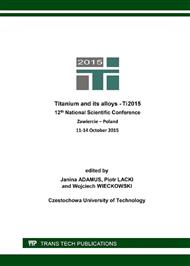[1]
J.D. Bronzino, D.R. Peterson ed., Biomedical Engineering Fundamentals, Fourth Edition, CRC Press, Boca Raton (2015).
Google Scholar
[2]
H. Quan, S. Gao, M. Zhu, H. Yu, Comparison of the torsional fretting behavior of three porous titanium coatings for biomedical applications, Tribol Int 92 (2015) 29-37.
DOI: 10.1016/j.triboint.2015.05.017
Google Scholar
[3]
J.S. Kim, K.M. Lee, D.H. Cho, Y.Z. Lee, Fretting wear characteristics of titanium matrix composites reinforced by titanium boride and titanium carbide particulates, Wear 301 (2013) 562-568.
DOI: 10.1016/j.wear.2012.12.041
Google Scholar
[4]
P. Ducheyne, K. Healy, D.E. Hutmacher, D. Grainger, C.J. Kirkpatrick, Comprehensive biomaterials (6 volume set), Elsevier, Oxford (2011).
Google Scholar
[5]
F. Billi, E. Onofre, E. Ebramzadeh, T. Palacios, M.L. Escudero, M.C. Garcia-Alonso, Characterization of modified Ti6Al4V alloy after fretting-corrosion tests using near-field microscopy, Surf Coat Tech 212 (2012) 134-144.
DOI: 10.1016/j.surfcoat.2012.09.034
Google Scholar
[6]
H. Cimenoglu, M. Gunyuz, G.T. Kose, M. Baydogan, F. Ugurlu, C. Sener, Micro-arc oxidation of Ti6Al4V and Ti6Al7Nb alloys for biomedical applications, Mater Charact 62 (3) (2011) 304–311.
DOI: 10.1016/j.matchar.2011.01.002
Google Scholar
[7]
M. Kiel-Jamrozik, J. Szewczenko, M. Basiaga, K. Nowińska, Technological capabilities of surface layers formation on implant made of Ti-6Al-4V ELI alloy, Acta Bioeng Biomech 17 (2015) 31-37.
Google Scholar
[8]
F. Yıldız, A.F. Yetim, A. Alsaran, A. Çelik, İ. Kaymaz, İ. Efeoğlu, Plain and fretting fatigue behavior of Ti6Al4V alloy coated with TiAlN thin film, Tribol Int 66 (2013) 307-314.
DOI: 10.1016/j.triboint.2013.06.006
Google Scholar
[9]
S. Wang, F. Wang, Z. Loao, Q. Wang, Y. Liu, W. Liu, Study on torsional fretting wear behawior of a ball-on-socket contact configuration simulating an artificial cervical disk, Mater Sci Eng C 55 (2015) 22-33.
DOI: 10.1016/j.msec.2015.05.056
Google Scholar
[10]
C. Paulin, S. Fouvry, C. Meunier, Finite element modeling of fretting wear surface evolution: Application to a Ti-6Al-4V contact, Wear 264 (2008), 26-36.
DOI: 10.1016/j.wear.2007.01.037
Google Scholar
[11]
A. Neyman, Fretting in elements of machines, Gdansk University of Technology Publishing, Gdańsk, 2003 (in polish).
Google Scholar
[12]
E. Andrysewicz, J.R. Dąbrowski, G. Leonow, Methodical aspects of rheological study on saliva, Your Stomatologic Industry. Thematic issue, (2008) 10-15 (in polish).
Google Scholar
[13]
E. Andrysewicz, J. Mystkowska, J. Kolmas, M. Jałbrzykowski, R. Olchowik, J.R. Dąbrowski, Influence of artificial saliva compositions on tribological characteristics of Ti-6Al-4V implant alloy, Acta Bioeng. Biomech. 14 (4) (2012), 71-79.
Google Scholar
[14]
J.R. Dąbrowski, M. Klekotka, J. Sidun, Fretting and fretting corrosion of 316L implantation steel in the oral cavity environment, Eksploatacja i Niezawodnosc - Maintenance and Reliability 16 (3) (2014) 441-446.
DOI: 10.3390/ma13071561
Google Scholar
[15]
P. Deptuła, J.R. Dąbrowski, A. Sobolewski, Titanium composite - potential implant biomaterial, Eng. Biomat. 106/108 (2011) 129-132.
Google Scholar
[16]
J. Mystkowska, P. Suder, A. Drabik, A. Bodzoń-Kułakowska, J. Silberring, J.R. Dąbrowski, Evaluation of the possibly of mucin adsorption onto implantation materials, Solid State Phenom. 199 (2013) 550-555.
DOI: 10.4028/www.scientific.net/ssp.199.550
Google Scholar
[17]
J. Coates, R.A. Meyers ed., Interpretation of Infrared Spectra, A Practical Approach in Encyclopedia of Analytical Chemistry John Wiley & Sons Ltd, Chichester, (2000) 10815-10837.
Google Scholar


